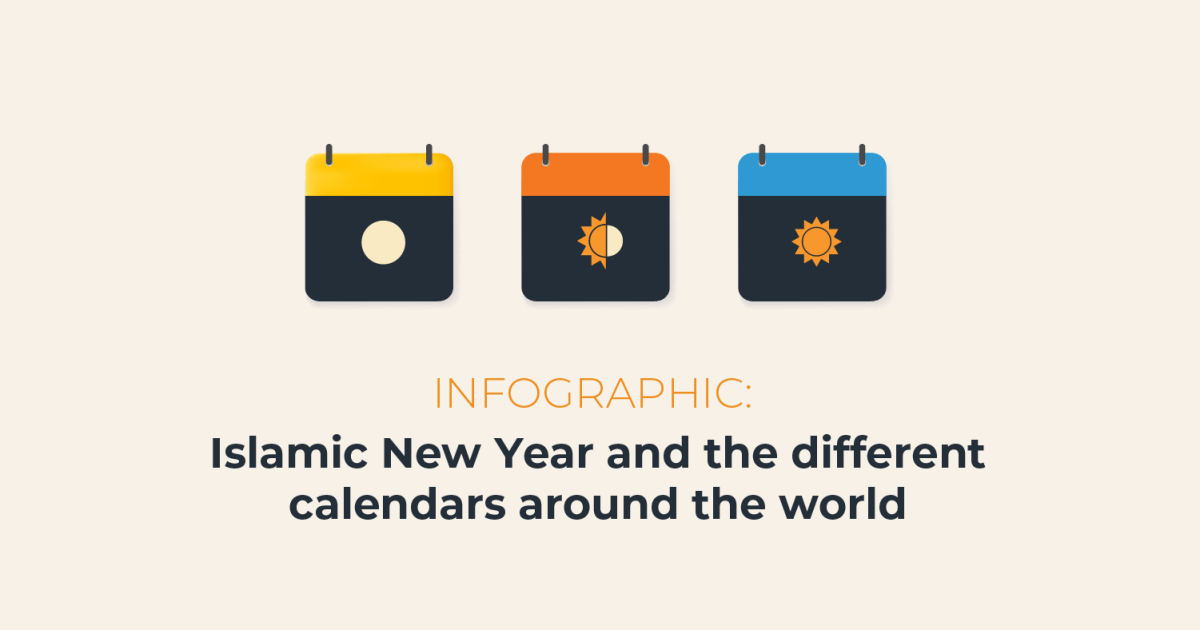
The arrival of the new crescent moon marks the start of the year 1444 on the Islamic lunar calendar.
July 30 is Islamic – or Hijri – New Year’s Day and marks the start of the year 1444.
The Hijri calendar, which comes from the Arabic word “hijra”, is named for the migration of the Prophet Muhammad from Mecca to Medina more than 1,400 years ago.
The 12 Hijri calendar months are determined by the sighting of the new moon. The first month is Muharram and the last is Dhul-Hijjah.
The Hijri calendar is used to mark important dates for Muslims such as the beginning of the fasting month of Ramadan, Eid al-Fitr at the end of it, and the start of the Hajj pilgrimage and Eid al-Adha.
How old are you according to the Hijri calendar?
A Hijri month alternates between 29 and 30 days. This makes a Hijri year about 11 days shorter than the Gregorian, with one year coming to 354-355 days.
So your Hijri age may be different from your Gregorian age. Here’s how to calculate it:
If you’re younger than 16: Your Hijri age is the same as your Gregorian age
If you’re between 16 and 48: Add one year to your current Gregorian age
If you’re between 49 and 81: Add two years to your age
If you’re older than 81: Add three years to your age
Other calendars around the world
Many religions and cultures use calendars other than the Gregorian – which is the most widely used calendar today.
The Gregorian calendar was introduced in October 1582 by Pope Gregory XIII as a modification to the Julian calendar, named after Julius Caesar, leader of ancient Rome.
The Gregorian and Julian calendars are both 12-month solar calendars based on the time it takes the Earth to complete one revolution around the Sun – a bit more than 365 days.
Other types of calendars include the lunar, lunisolar and fixed calendars.
A lunar year is 12 lunar months, each measuring the time it takes the moon to pass through its phases, i.e. new moon, half moon and full moon.
A lunar month is about 29.5 days long and a lunar year is approximately 354 days. This means that every 33 years, there is a one-year lag between solar and lunar calendars.
A lunisolar year incorporates both lunar and solar characteristics, where the year is divided according to the phases of the moon, but adjusted to correlate with the solar cycle length. Lunisolar calendars include the Buddhist, Chinese, Hindu, Jewish, Korean and Tibetan calendars.
Other New Year celebrations this year
The following dates are some new years from different religions and cultures in 2022.
Gregorian New Year – The Gregorian calendar begins on January 1 every year and is currently in the year 2022.
Lunar New Year – Also known as Chinese New Year. This calendar uses a lunisolar system. The new year is marked on January 22 and China usually celebrates for 15 days. 2022 in the Chinese calendar is the Year of the Dog.
Sikh New Year – The Nanakshahi calendar derives its name from the founder of Sikhism, Guru Nanak. The new year is marked on March 14.
Persian New Year – Also known as Nowruz. The Persian calendar is solar, with the new year beginning on March 21.
Hindu New Year – Is on April 1 and is based on the Vikram Samvat lunisolar calendar, which is used across the Indian subcontinent. It is usually 57 years ahead of the Gregorian calendar.
Thai New Year – Also known as Songkran, this is the biggest of Thailand’s annual festivals and is celebrated on April 13 every year. It follows a solar calendar system.
Jewish New Year – The traditional Jewish lunisolar calendar begins on Rosh Hashanah. This year it will be marked on September 25, however, the date varies according to the Jewish months.








